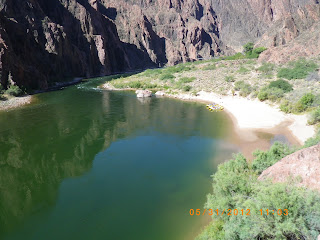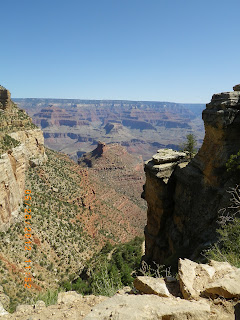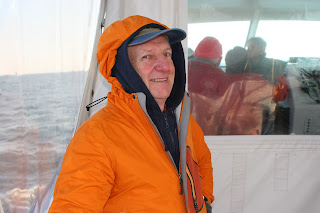Backpacking Rim-2-Rim Grand Canyon Arizona
Part 2
Many people ask me why I would ever consider backpacking the Grand Canyon, and I answer by saying, "Because it is one of the many great wonders of the world that was created by God." We often get so bogged down with the every day routine of work and family life that we take for granted the great things in nature that God has created for our enjoyment. It is exciting to walk some of the same trails that our pioneers and first explorers walked many years before. I also feel a special kinship with them when I put on a backpack with all of the necessities of life such as food ,water, shelter, clothing, and hike in much the same way as they did in the beginning. The excitement of knowing that if you hike into the canyon you must hike out because there is no other way out unless you are seriously injured. You are on your own. A helicopter port is located at every campground and at selected sites for the "bumblebee" copter ride out for the injured. I also enjoy meeting and talking to fellow hikers along the trail. They come from all over the world to hike the Canyon. No matter what language they speak we all have the beauty of the canyon as a common bond.
Phantom Ranch
I ended Part 1 staying at the Bright Angel Campground near the Phantom Ranch. My two hiking companions and I stayed two days at the campground. The ranch is the only overnight lodging below the rim. It has eleven rustic cabins and two dormitories along the banks of Bright Angel Creek surrounded by cottonwood trees. A canteen serves home-cooked meals; showers and flush toilets add a touch of luxury. The ranch acts as an overnight station for rafters and mule riders. Reservations for the ranch are accepted 13 months in advance and sell out within a few hours on the first day on January. I applied for a camping permit for the three of us for a end of May hike. Approximately 70 thousand people apply to overnight hike for the months of May and September, and only 15 thousand are accepted--most of which are overnight hikers coming down from the South Rim. Not many people hike from Rim-2-Rim.
Bright Angel Campground
(photo was taken by Arnold Leonard)
There is a T-shaped metal pole on the left side of this picture, and it is designed for the hiker to hang pack on the top to keep animals from getting into it. The biggest problem are the ground squirrels. Ground squirrels look like tree squirrels but they live in holes in the ground and can jump high for long distances. They often jump up to the hanging packs and raid anything that is not in a metal container. I saw one squirrel jump onto a hanging pack, disappearing under the flap only to reappear within minutes with a chocolate cookie in its mouth. Most of our food was keep safe from animals in large military metal ammunition boxes provided by the campground. Each campground had national park rangers who provided care and guidance and evening programs to campers and lodge members. The campsite was great but the flush toilets were not working, and we had to carry water from the nearby stream to flush it after each use. The ranger explained that the rocks do a lot of shifting and tend to cause a break in the pipes supplying water to the ranch and campground. Sometimes when a water line runs along the trail a waterline breakage can wash out part of the trail. One such wash out did occur, and it washed out over 50 feet of trail. Fortunately we were already past that point in the trail. Some hikers were less fortunate and had to back track back to the beginning the trail.

Ground Squirrel looking for a hand out.
We hiked around the Phantom Ranch onto the Clear Creek Trail. This trail climbs high above the Phantom Ranch at several advantage point overlooking the Colorado River. Views of the South Kiabab and Bright Angel Trails can clearly be seen from this point. I sat on a large rock and watched as the mule trains carrying up to twenty riders slowly made their way down the South Rim. I could also watch the whitewater rafters float down the river. The Colorado River is a pretty green with very little silt in it because of the two dams on the river above and below the canyon.
 Wooden Deck Suspension Bridge
Wooden Deck Suspension Bridge
If you look closely you can see the trail that carries mule riders down the South Rim.
Crossing Bridge
There are two suspension bridges one metal and one wooden. They cross the Colorado River from the South Rim.
Colorado River
At the right edge of the river you may be able to see some rafters who have stopped to visit the Phantom Ranch (2,400 feet above sea level). The trip began on top of the North Rim at 8,250 feet above sea level.
Tunnel
All mule riders coming to the Phantom Ranch from the South Rim via the South Kiabab Trail must come through a short tunnel in the rocks before crossing to the Colorado River.
Mule Train mule fitted for riding
(photo taken by Hezekiah Goodson)
Can you imaging riding a mule and having to squeeze through this tunnel? Most mule riders are given an hour long presentation by the mule team leader on what to expect and how to ride a mule. I overheard a mule team leader telling one young teenager that the mule she was riding liked to hug the outside of the trail next to the drop off. I know that probably did wonders for her confidence in riding mules on a skinnny trails.
The temperature in the Bottom of the canyon is 120 degrees
(photo was taken by Arnold Leonard)
The temperature at the bottom of the canyon is usually 20 to 25 degrees warmer than at the rim. At night it was 101 degrees with no air circulation and was a very dry heat. We were encouraged to sit in the Bright Angel Creek during the day to keep cool. As soon as we got out of the water we dried very quickly.
Indian Ruins
Native American tribes of the Hopi, Havasupi, Navajo, and Southern Paiute inhabited the Grand Canyon around A.D. 1300. There are many ruins from their existence near the Phantom Ranch along the Colorado River.
The Box
In order to get to the next campsite-- Indian Garden-- we had to hike through "The Box." The Box is a narrow canyon with high rock walls on both sides. Temperatures in the canyon can reach dangerously high levels in the Box if it is not passed before noon. Many hikers start well before sunrise to be sure to get through the canyon on time. It was strange seeing groups of hikers with their headlamps on bouncing past our campground like little fireflies at night. We left at around 5:30 AM and had no trouble getting through it. If you look very closely you can see the trail at the bottom of the canyon.
Sunrise shadows
I loved hiking in the morning, watching the sunrise cast shadows of one canyon wall onto another.
South canyon trail
The Bright Angel Trail leading to Indian Garden Campground was very easy to walk on because it consisted of a loosely packed weathered sedimentary soil. At no time did we have to rock scramble or walk on loose boulders. The trail was easy for mules to walk upon. The mule train guides were very proud to say that they have never lost a tourist or riding mule in the history of mule trips.
Indian Garden campground
Indian Garden Campground was the last overnight stop before we reached the South Rim--the end of our backpacking trip. The campground was an oasis of green in the desert. Native Americans settled here because there was an ample supply of water and available food to eat. The Grand Canyon is a desert with hot and dry conditions without the sand-like environment you see in traditional deserts on television. We always had access to water along the trail and didn't have to worry about dehydration.

The next morning at 4:00 equiped with headlamp on I left to get a jump start before the sun came up. I was well into the last 5 miles before the sun came up. The last 5 miles was loaded with people of all nationalities hiking down from the South Rim. Many people like to hike several miles down the rim just to get an idea of what it is like to hike the Bright Angel Trail and to be able to say they hiked the Grand Canyon.

Hiking through one of the tunnels along the trail.
(Photo taken by Arnold Leonard)
Along this section of the trail there are warning signs to help keep hikers safe.
At the end of the trail at the top of the South Rim.
A happy smiling finished backpacker!
Isaiah 40:4-- Every valley shall be exalted, and every mountain and hill shall be made low: and the crooked shall be made straight, and the rough places plain.
The Following Photos Taken by Arnold Leonard













































